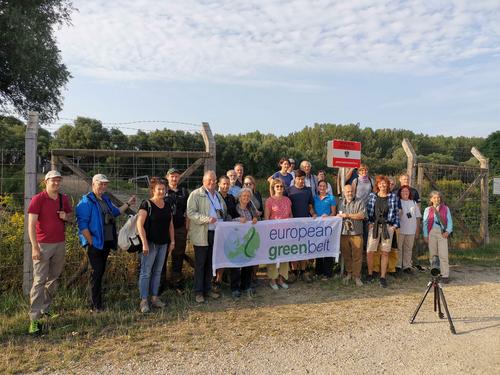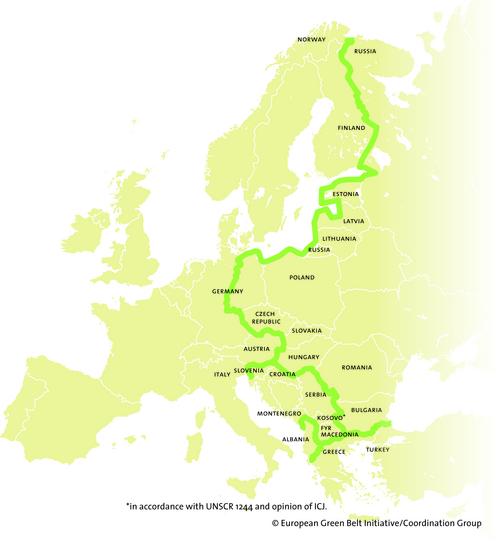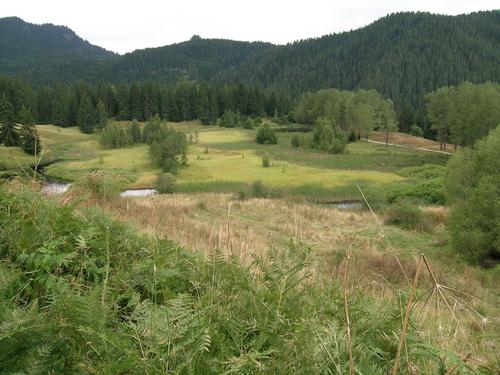Impulse for a big project: European Green Belt should become UNESCO-world heritage

Participants of the 'Paneuropean Picknick" at the border of Austria and Hungary
© BUND Bayern
Along more than 12,500 kilometres – from the Barents Sea at the Russian-Norwegian border, along the Baltic Coast, through Central Europe and the Balkans to the Black and the Adriatic Sea – the border zone granted nature a pause and has created a zone of life.
© European Green Belt Initiative/Coordination Group
EuroNatur is the regional coordinator of the southernmost section of the Balkan Green Belt. There is a landscape mosaic of untouched forests, enchanted moors and unspoilt mountain landscapes.
© Green BalkansRadolfzell, Nürnberg, Illmitz, Modra. The European Green Belt is an extraordinary, 12,500 km long ecological network that has developed along the former Iron Curtain, which separated Europe over the course of four decades. The European Green Belt unifies the dimensions of ecology and history in a unique way. It is a habitat and migration corridor for a large number of endangered species as well as a living memorial landscape of recent European history. The Green Belt is thus not a parable for separation, but a symbol for the symbiosis of nature conservation and culture of remembrance. The 3-day tour along the European Green Belt in Austria, Hungary and Slovakia organised by BUND Department Green Belt is accompanied by journalists from five countries.
“30 years after the breakdown of the Iron Curtain the European Green Belt is a unique symbol for transnational, peaceful cooperation and by that represents the European Idea itself”, said Prof. Dr. Hubert Weiger, chair of Friends of the Earth Germany (BUND für Umwelt und Naturschutz Deutschland, BUND), one of the initiators of the European Green Belt. “In 2018 the Green Belt in the Federal State of Thuringia was declared a ‘National Nature Monument’ – a strictly protected and with its length of 763 kilometers the longest protected area at the Green Belt. This is a strong signal for the European Green Belt because the reasons for the declaration are also valid in a broader, European scale. This could give a push forward for a nomination as UNESCO world natural and cultural heritage“, Weiger added. Currently there are efforts to nominate the Green Belt Fennoscandia a UNESCO world heritage. The fact that the presidency of the Council of the European Union was just taken over by Finland could be a positive impulse for taking the necessary steps for a nomination of the Green Belt as a whole by getting more and more affected countries engaged.
Like the pearls on a necklace numerous protected areas are situated along the Green Belt. In order to better connect these pearls with each other and especially across borders and to secure the connecting corridors, 11 organisations from 8 countries are cooperating under the leadership of BUND in the EU-funded project "DaRe to Connect (D2C)". 49 national parks alone, 19 of which are cross-border, are located directly at the European Green Belt and 7,319 protected areas are lined up in a 50 km wide corridor. In addition, the distances between the protected areas are smaller than in the surrounding landscapes. This makes it possible for many species to migrate between different regions in the first place. This is no longer a matter of course for genetic diversity within populations and in an increasingly densely populated Europe. Especially with regard to climate change, the North-South migration corridor, which the Green Belt represents for large mammals such as lynx, wolf, bear and elk, is of inestimable value.
"The Green Belt delivers an important contribution to the European network of Natura 2000 areas and serves as a Pan-European backbone to connect habitats and green corridors. In addition, nature provides vital services for people here, such as the provision of fresh water, clean air and healthy soil. The contribution of the Green Belt to the 'green infrastructure' of the EU cannot be overestimated," says Martin Geilhufe, spokesman for the BUND Federal Working Group on International Environmental Policy.
"In order to preserve our common European natural heritage, people's awareness of this unique lifeline must be strengthened. To date, only half of the area in a one kilometre wide corridor along the Green Belt has a status as protected area. Intensive land-use, construction of roads and buildings, but also illegal logging and poaching threaten this natural treasure. Initiatives and partnerships, especially for sustainable regional development (e.g. nature tourism), must be further developed and strengthened in order to counteract these threats and interventions," says Dr. Liana Geidezis, head of BUND Department Green Belt.
"The Green Belt Europe is one of the most important trans-European networks of biological diversity. With the European Green Belt Association (EGBA) we are working to establish the Green Belt as a central element of the Pan-European green infrastructure and to implement concrete activities and measures for the conservation and renaturation of this ecological network within the framework of the corresponding EU strategy with the help of suitable funding opportunities", says Gabriel Schwaderer, Executive Director of the EuroNatur Foundation, which chairs the EGBA.
The press trip started in the Neusiedler See - Seewinkel National Park, where the endangered bustards and barn owls can be found today. Here the Federal Environment Agency Austria, the Austrian League for Nature Conservation and the Federal Ministry for Sustainability and Tourism organised a jubilee event on 19th of August, the 30th anniversary of the "PanEuropean Picnic". The importance and future of the Green Belt as a natural and cultural monument were discussed with high-ranking international participants. "The special ecological value of the Green Belt lies in the fact that it is an interwoven and holistically functioning ecosystem of various habitats," said Prof. Dr. Johannes Gepp, Vice President of the Austrian League for Nature Conservation.
Afterwards the trip went to Modra in Slovakia. "The Green Belt and the Alpine-Carpathian Corridor are two ecological networks of Europe-wide significance for biodiversity. The region thus plays a central role in preserving biodiversity", said Ivan Koubek, representative of the State Nature Conservancy of the Slovak Republic and national focal point for the Green Belt Slovakia. This section of the Green Belt is home to one of six pilot regions of the Interreg project D2C. The experts of the partner organisations are investigating and mapping potential ecological corridors and existing barriers such as fences, power lines and roads that hinder or even prevent migration of species between biotopes.
Today, numerous people from 150 institutions in the 24 neighbouring countries are involved in the Green Belt Europe initiative. This living monument commemorates the peaceful overcoming of the Cold War and the Iron Curtain. Through European cooperation, it transforms the tragic history of the 20th century into a sign against borders and for nature.
Further information: Christian Stielow, christian.stielow(at)euronatur.org, Tel. +49 7732 927215


